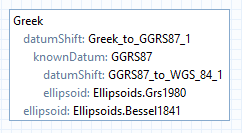DatumShift.KnownDatum Property
Gets the known datum, usually WGS84.
Syntax
public GeodeticDatum KnownDatum { get; }Property Value
Default: Differs depending on type. See the table below.
The known datum that the transformation goes to (or from).
Default values
Remarks
Sometimes, it is necessary to use a different known datum. For example, if you want to implement the old datum Greek, you will find that EPSG publishes two datum shifts from Greek to another datum:
"Greek to GGRS87 (1)"; this is a single LongLatOffsetDatumShift.
"Greek to WGS 84 (1)"; this is a concatenation of the above shift and another that continues to WGS 84.
In Carmenta Engine, you cannot represent the concatenated form directly as a sequence of datum shifts. Instead, you must first implement the intermediate GGRS87 datum (using the Helmert datum shift "GGRS87 to WGS 84 (1)"). Then, you can use GGRS87 as the known datum for your implementation of the LongLatOffsetDatumShift "Greek to GGRS87 (1)".
 |
Platforms
Windows, Linux, Android